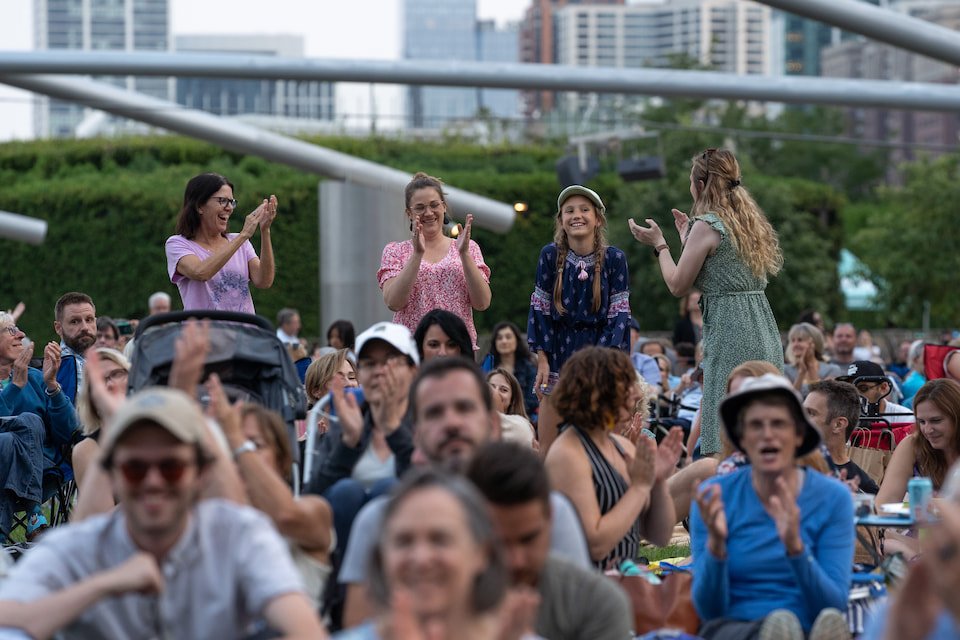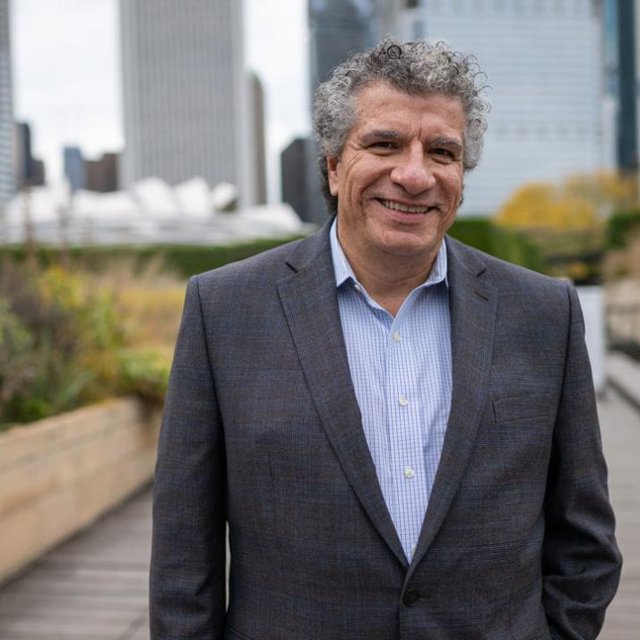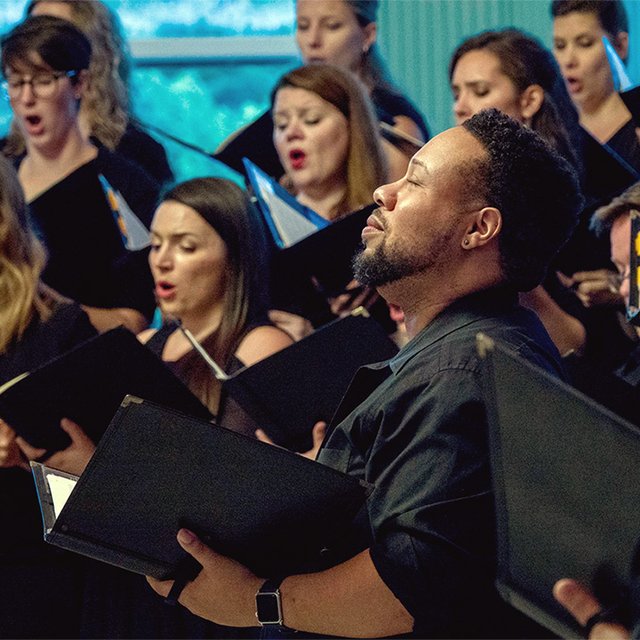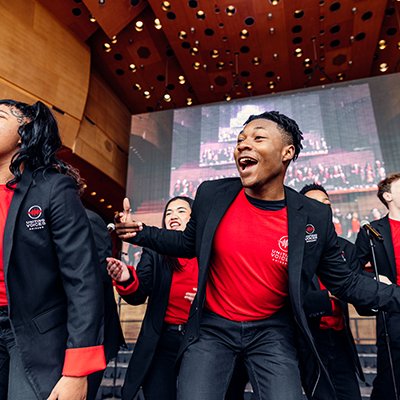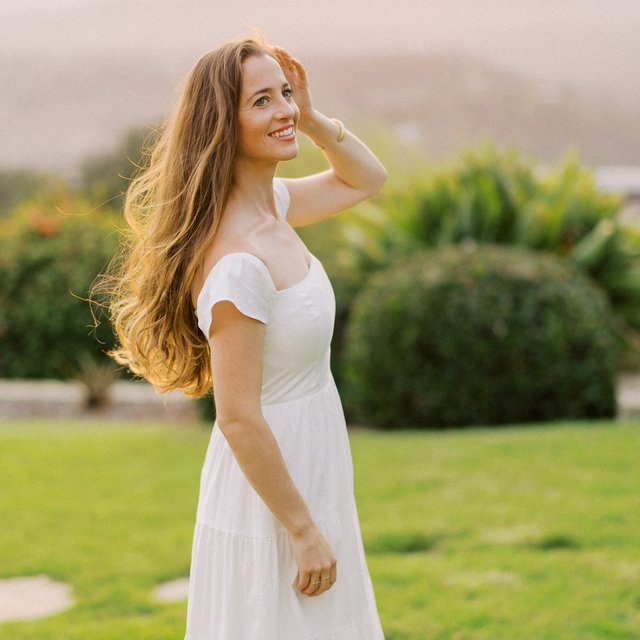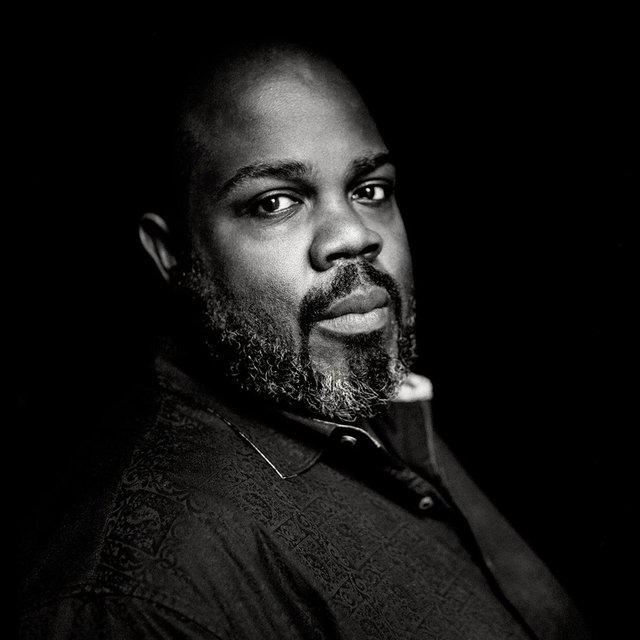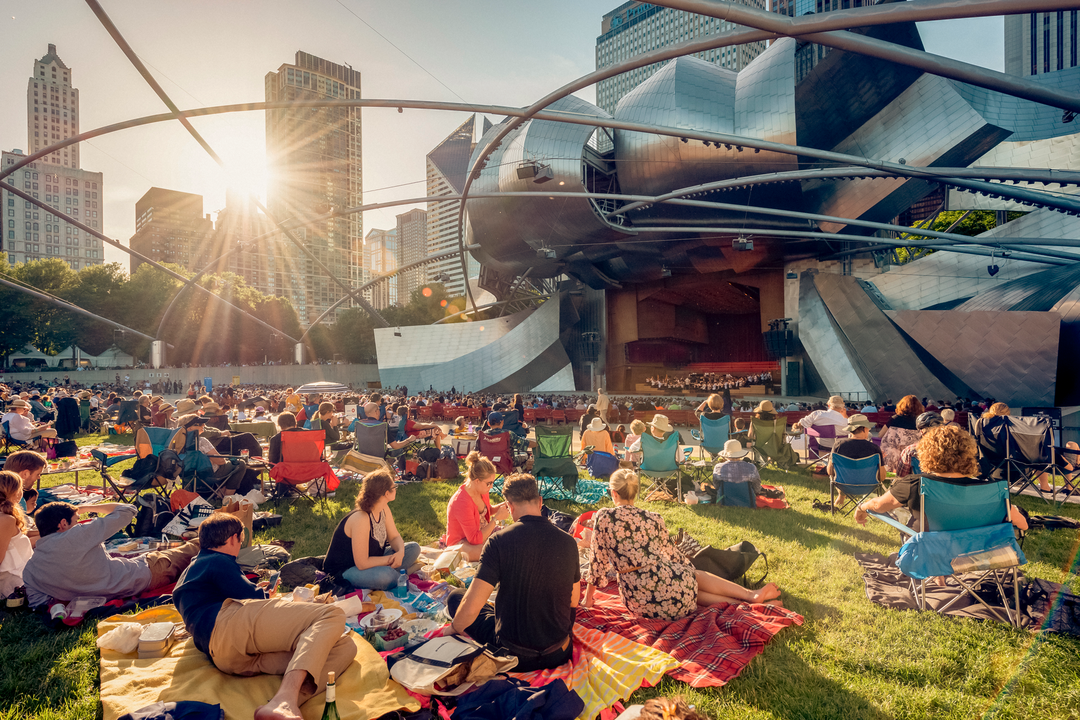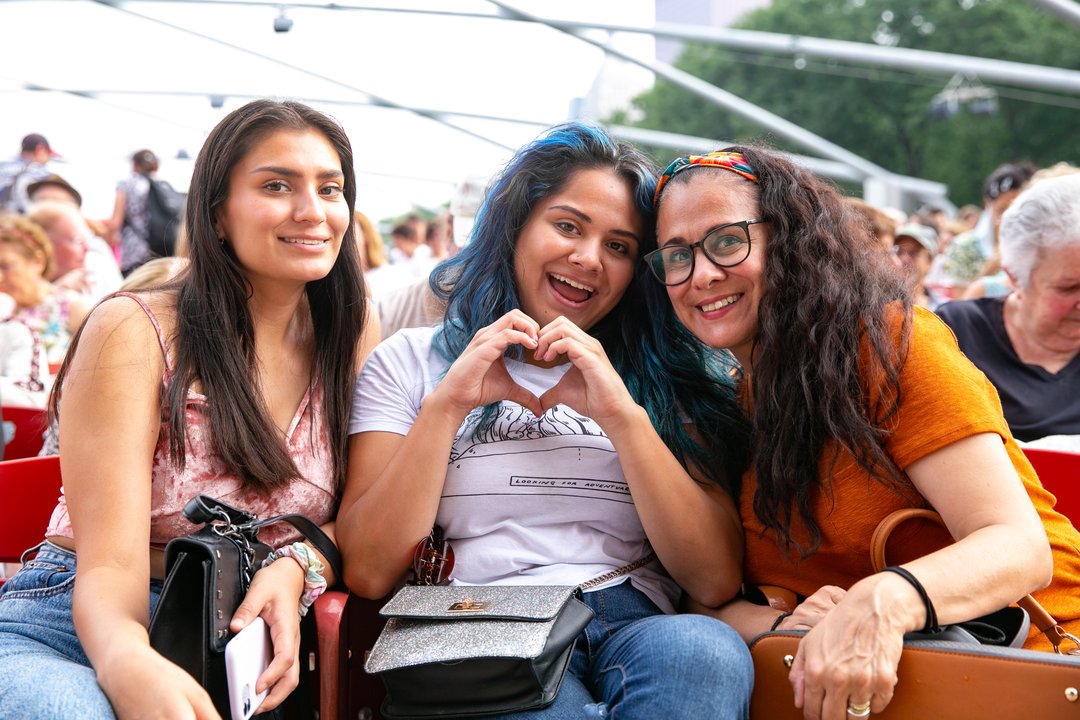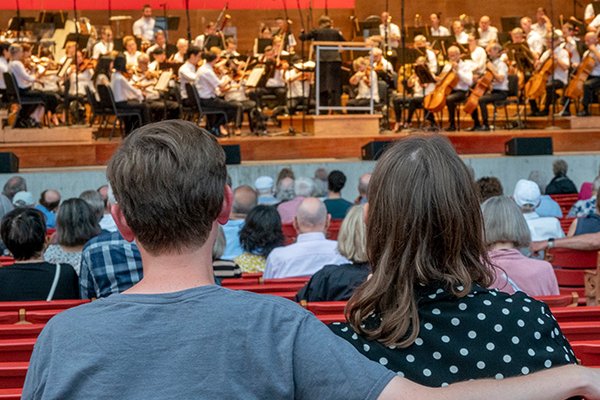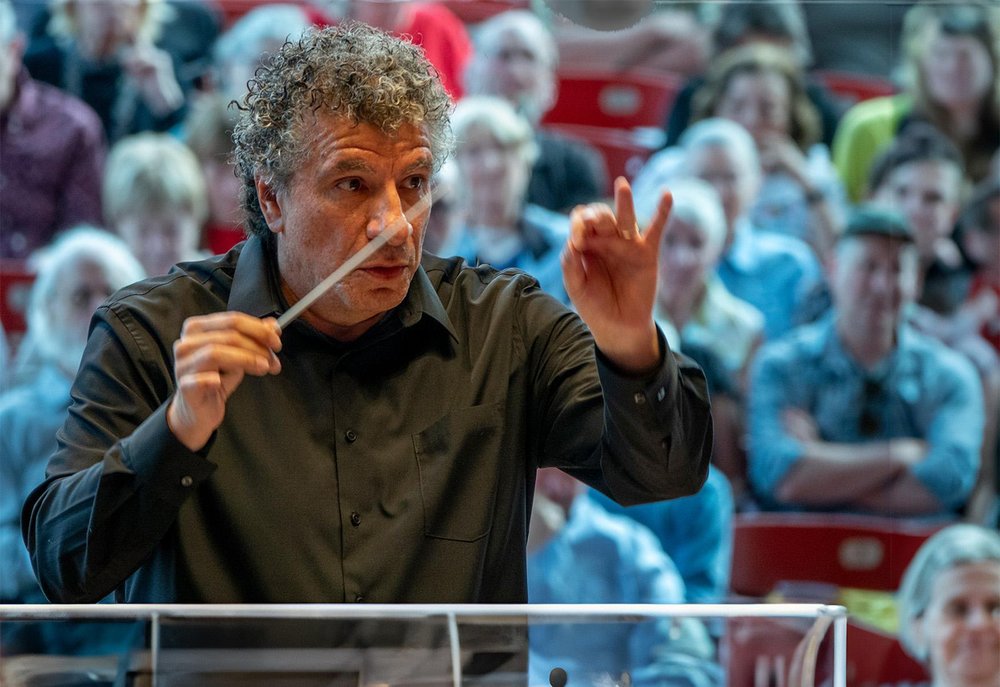
Carmina Burana
Program
Nikolai Rimsky-Korsakov Russian Easter Overture (14 mins)
Alan Hovhaness Symphony No. 2, Mysterious Mountain (19 mins)
Andante con moto
Double Fugue: Moderato maestoso – Allegro vivo
Andante espressivo: Con moto
Intermission (20 mins)
Carl Orff Carmina Burana (65 mins)
Fortune, Empress of the World
In Springtime
On the Green
In the Tavern
The Court of Love
Blanziflor and Helena
Fortune, Empress of the World
Featuring
Program Notes
Nikolai Rimsky-Korsakov (1844–1908)
Russian Easter Overture (Svetlïy prazdnik; Grand Paque russe), op. 36 (1888)
Scored for: three flutes including piccolo, two oboes, two clarinets, two bassoons, four French horns, two trumpets, three trombones, tuba, timpani, percussion, harp, and strings
Performance time: 14 minutes
First Grant Park Orchestra performance: July 21, 1939; Richard Czerwonky, conductor
In 1887–88, Nicolai Rimsky-Korsakov was at the height of his creative powers, composing his three most famous and enduring works: Scheherazade, Capriccio Espagnol, and the Russian Easter Overture. The composer later wrote, “[these works] close a period of my work at the end of which my orchestration had attained a considerable degree of virtuosity and bright sonority without Wagnerian influence.”
In the Russian Easter Overture, Rimsky-Korsakov sought to highlight the roots of Orthodox Easter traditions in old pagan spring celebrations, with their emphasis on the transformation of darkness into light. Even though he was not a believer, he had served as Mily Balakirev’s deputy at the Court Kapella. There, he explored Russian church music for the first time—a previously unexplored medium for Russian nationalist composers. For his Easter Overture, the composer took melodic inspiration from the Obikhod, a book of Russian Orthodox liturgical chants. He also put together a programmatic outline of the piece by including various biblical quotations in the preface to the score, beginning with Isaiah’s prophecy of the resurrection of Christ and traversing St. Mark’s account of the Passion.
The overture begins in the unusual time signature of 5/2 with unison woodwinds introducing the first theme, “Let God Arise” from the Obikhod. After a violin cadenza, a solo cello introduces the second liturgical theme, “An Angel Cried Out,” against the twinkling backdrop of flute, harp, and violin. The themes are repeated in various orchestrations, punctuated by solo cadenzas for different instruments. The minor allegro agitato section alternates with brilliant major-mode brass fanfares, representing the struggle between darkness and light. A solemn chant in the solo trombone delays the heathenistic merrymaking until the allegro returns, ending with a triumphant, bell-filled coda. Rimsky-Korsakov describes the scene: “‘Resurrexit!’ sings the chorus of heavenly angels to the sound of the archangels’ trumpets and the fluttering of the wings of seraphim. ‘Resurrexit!’ sing the priests in the temple, amid clouds of incense, by the light of innumerable candles, to the chiming of triumphant bells.”
Alan Hovhaness (1911–2000)
Symphony No. 2, Mysterious Mountain, op. 132 (1955)
Scored for: three flutes, three oboes including English Horn, three clarinets including bass clarinet, three bassoons including contrabassoon, five French horns, three trumpets, three trombones, tuba, timpani, harp, celesta, and strings
Performance time: 19 minutes
First Grant Park Orchestra performance: July 30, 1997; Jesus Lopez-Cobos, conductor
Armenian-American composer Alan Hovhaness (born Alan Vaness Chakmakjian) was one of the most prolific composers of the last century, with 434 opus numbers to his name, including 67 symphonies. His most enduring orchestral work is Symphony No. 2, “Mysterious Mountain.” Conductor Leopold Stokowski commissioned the piece for his first concert with the Houston Symphony in 1955—a performance that was telecast nationally on NBC. The symphony marked Hovhaness’s first popular success, thanks in part to the auspicious premiere and to a highly celebrated recording by Fritz Reiner and the Chicago Symphony Orchestra released in 1958.
The subtitle “Mysterious Mountain” was added at Stokowski’s request to draw listeners in. While Hovhaness did not have the title in mind while composing the piece, the symphony’s placid, grounded atmosphere and steadily built climaxes make it an apt one. “Mountains are symbols, like pyramids, of man’s attempt to know God,” Hovhaness writes in his program note. “Mountains are symbolic meeting places between the mundane and spiritual world. To some, the Mysterious Mountain may be the phantom peak, unmeasured, thought to be higher than Everest, as seen from great distances by fliers in Tibet. To some, it may be the solitary mountain, the tower of strength over a countryside—Fujiyama, Ararat, Monadnock, Shasta, or Grand Teton.”
Beginning in a mood of mystical reverence, the Andante con moto alternates between slow, hymn-like sections decorated by harp and celesta and gentle solo passages for various instruments. Vaughan-Williams’s Fantasia on a Theme by Thomas Tallis comes to mind, not least for its Phrygian modality and English cadences but also its lush, divided string scoring. Hovhaness’s thorough study of counterpoint as a young composer is evident in the masterful double fugue of the second movement. The first subject is a pentatonic theme developed in the style of 16th-century vocal polyphony. Breaking the symphony’s predominantly peaceful mood is the vigorous second subject, scored for strings alone. The two subjects combine when the first subject reappears in the horn, eventually building to a majestic climax in full orchestra. The third movement, marked Andante espressivo, returns to the contemplativeness of the opening Andante. Hovhaness’s abiding interest in Indian music is manifest in the use of a 13-beat raga-like chant, which builds like a wave before eventually receding into an atmosphere of spiritual rapture.
Carl Orff (1895–1982)
Carmina Burana (Songs of Beuren) (1936)
Scored for: three flutes including piccolo, three oboes including English Horn, three clarinets including bass clarinet, three bassoons including contrabassoon, four French horns, three trumpets, three trombones, tuba, timpani, percussion, celesta, piano, strings, chorus, children's chorus, solo soprano, solo countertenor, and solo baritone
Performance time: 65 minutes
First Grant Park Orchestra performance: August 4, 1962; Julius Rudel, conductor and Teresa Orantes, soprano; John Alexander, tenor; and Sherrill Milnes, baritone
Instantly recognizable, the iconic opening chorus of Carmina Burana, “O Fortuna,” has featured in countless films, TV shows, and commercials selling everything from pizza to cologne to cell phones. With its dramatic Latin text and scoring for massive chorus and orchestra, one might assume that Carmina Burana is a solemn, religious opus. But that couldn’t be farther from the truth.
One day in 1934, composer Carl Orff was browsing a rare bookshop in Würzburg when he stumbled upon “a title that attracted me with magical force,” he later recalled. The book was an edition of the Carmina Buranacodex compiled by Johann Andreas Schmeller in 1847. The Carmina Burana codex is a collection of secular poems in Latin, High Middle German, and Old Provençal dating from the 11th to 13th centuries. These texts were primarily written by “goliards,” itinerant student clerics who penned satirical, often bawdy poetry to vent their frustrations at the Church and the clergy in positions of power. Translating to “songs of Beuern,” the Carmina Burana codex is so-called because it was discovered in the Benediktbeuern monastery in the foothills of the Bavarian Alps.
Orff was particularly struck by the image on the first page of the goddess Fortune with her wheel and under it the lines, “O Fortuna, velut luna statu variabilis” (“O Fortune, like the moon ever-changing”). That same day, he sketched the chorus that would open and close Carmina Burana. He enlisted the help of archivist Michel Hofmann to select and arrange 24 poems from the collection into a libretto of sorts. While there is no overarching story, the cantata’s three sections are self-contained vignettes on the themes of springtime and renewal (Primo vere/Uf dem anger), drinking and gambling (In taberna), and love and pleasure (Cour d’amours). “O Fortuna” bookends the cantata, symbolizing the continual rotation of the Wheel of Fortune and putting the central earthly pleasures in tension with the inescapability of fate. Conceived as a stage work, Carmina Burana premiered in 1937 at the Frankfurt Opera, complete with costumes, sets, and dancers. Today, however, the immediacy of Orff’s music speaks for itself.
Setting these subversive, mostly Latin texts was a risky move on Orff’s part, as they contradicted the National Socialists’ construct of “Germanness.” Plus, the image of the Wheel of Fate ultimately bringing down those in power could have been perceived as incendiary (“Too high up sits the king at the top, let him beware of a downfall, for under the wheel we see Queen Hecuba”). Nevertheless, Carmina Burana was received enthusiastically, even among critics from the National Socialist Party. Orff was able to make the text’s darker and more scandalous elements palatable to a wide audience through his emotionally direct and accessible musical language. The score is largely tonal and homophonic, featuring memorable melodies and energetic rhythmic patterns in short, often strophic numbers. References to German folk music further shielded Orff from reproach.
Another key to Carmina Burana’s enduring success is its variety of musical expression, from the thunderous chords of “O Fortuna” and the sinister chanting of “In taberna quando sumus,” to the folk-like naiveté of “Chramer, gip die varwe mir” and lulling lyricism of “In trutina.” Orff makes full use of the vocal and instrumental forces at his disposal (which includes over two dozen percussion instruments, along with chorus, semi-chorus, children’s chorus, and three soloists), combining them in various ways for different effects. For instance, Orff marks the tavern as the exclusive domain of men by employing only the lower voices throughout In taberna. In contrast, the ensuing Cour d’amours marks the first time we hear the dulcet tones of the children’s chorus and soprano soloist.
Further variety of color is achieved by exploring the extremes of the soloists’ vocal ranges. In “Olim lacus colueram,” the lament of the swan roasting on the spit is set extremely high in the tenor’s range, giving the solo an intentionally strained quality. (As will be the case tonight, this aria is sometimes sung by a countertenor instead, making it less pained but perhaps more haunting.) In “Dies, nox et omnia,” the love-sick baritone swoons in his falsetto as the talk of girls makes him weep and sigh. The soprano is not exempt from these high tessitura demands either, leaping up a ninth to a high B in “Dulcissime” and wordlessly soaring to the D above as she decides to give into sensual pleasure.
—Katherine Buzard
Event Sponsors
This concert is generously supported as part of the Dehmlow Choral Music Series.
Artistic Leadership
Support The Festival
Violin I
Jeremy Black, concertmaster
Vacant, assistant concertmaster
Trista Wong
Zulfiya Bashirova
Jennifer Cappelli
Injoo Choi
Dima Dimitrova
Erica Hudson
Hyewon Kim
Matthew Lehmann
Jayna Park
Rika Seko
Karen Sinclair
Bonnie Terry
Krzysztof Zimowski
Violin II
Liba Shacht, principal
Vacant, assistant principal
Ying Chai
Ran Cheng
Karl Davies
Likai He
Ann Lehmann
Laura Miller
Cristina Muresan
Kjersti Nostbakken
Irene Radetzky
Jeanine Wynton
Thomas Yang
Viola
Terri Van Valkinburgh, principal
Yoshihiko Nakano, assistant principal
Elizabeth Breslin
Beatrice Chen
Amy Hess
Rebecca Swan
Chloé Thominet
Cello
Walter Haman, principal
Peter Szczepanek, assistant principal
Calum Cook
Larry Glazier
Steven Houser
Eric Kutz
Eran Meir
Double Bass
Colin Corner, principal
Peter Hatch, assistant principal
Andrew Anderson
Christian Luevano
Samuel Rocklin
Chunyang Wang
Chris White
Flute
Vacant, principal
Alyce Johnson
Jennifer Lawson, assistant principal
Piccolo
Jennifer Lawson
Oboe
Mitchell Kuhn, principal
Vacant
Anne Bach, assistant principal
English Horn
Anne Bach
Clarinet
Dario Brignoli, principal
Trevor O’Riordan, assistant principal
Besnik Abrashi
Bass Clarinet
Besnik Abrashi
Bassoon
Eric Hall, principal
Nicole Haywood Vera Tenorio, assistant principal
Vacant
Contrabassoon
Vacant
Horn
Vacant, principal
Stephanie Blaha, assistant principal
Neil Kimel
Brett Hodge
Paul Clifton
Trumpet
David Gordon, principal
Mike Brozick
Vacant, assistant principal
Vacant
Trombone
Daniel Cloutier, principal
Jeremy Moeller, assistant principal
Bass Trombone
Alexander Mullins
Tuba
Andrew Smith, principal
Timpani
Daniel Karas, principal
Josh Jones, assistant principal
Percussion
Josh Jones, principal
Vacant, assistant principal
Doug Waddell
Harp
Kayo Ishimaru-Fleisher, principal
Keyboards
Christopher Guzman
Orchestra Librarian
Eliza Bangert, principal
Grant Park Chorus
* denotes leave-of-absence † 2025 Vocal Fellow
Laura Lynch Anderson
Kristina Bachrach
Madalynn Baez
Megan E. Bell
Alyssa Bennett
Tamara Bodnar
Kylie Buckham
Anna Joy Buegel
Laura Bumgardner
Katherine Buzard
Bethany Clearfield
Nathalie Colas
Carolyne DalMonte
Megan Fletcher
Kaitlin Foley
Saira Frank
Julia Frodyma
Katherine Gray-Noon
Kimberly Gunderson
Alexandra Ioan
Alexandra Kassouf
Darlene Kelsey
Olivia Knutsen
Marybeth Kurnat
Katelyn Lee
Kyuyim Lee+
Rosalind Lee
Veronica Mak
Hannah Dixon McConnell
Marie McManama
Kathleen Monson
Susan Nelson
Evangeline Ng
Máire O'Brien
Alexandra Olsavsky
Laura Perkett
Angela Presutti Korbitz
Alexia Rivera
Veronica Samiec
Emily Sinclair
Molly Snodgrass
Tiana Sorenson
Christine Steyer
Sarah van der Ploeg*
Lydia Walsh-Rock
Sherry Watkins
Emily Amesquita
Melissa Arning
Christina Bernardoni
Angela Born
Bethany Brewer
Julie DeBoer
Leah Dexter
Katrina Dubbs
Stacy Eckert
Margaret Fox
Catarine Hancock
Ruth Ginelle Heald
Sophia Heinz
Miya Higashiyama
Carla Janzen
Amy Allyssa Johnson
Kathryn Kinjo Duncan
Amanda Koopman
Anna Laurenzo
Jeannette Lee
Thereza Lituma
Chelsea Lyons
Victoria Marshall
Jessica McCarthy
Quinn Middleman
Ella Peters
Sarah Ponder
Emily Price
Stephanie Schoenhofer
Suzanne A. Shields
Marissa Simmons
Cassidy Smith
Aidan Spencer
Alannah Spencer
Margaret Stoltz
Carolyn Sundlof Boudreau
Gabrielle Timofeeva López
Elizabeth Vaughan
Corinne Wallace-Crane
A.J. Wester
Debra Wilder
Isabel Yang+
Charles Anderson
Enrico Giuseppe Bellomo
Justin Berkowitz
Madison Bolt
Hoss Brock
Steven Caldicott Wilson
Opal Clyburn-Miller+
John J. Concepción
Micah Dingler
Jared V. Esguerra
Alec Fore
Ace Gangoso
Klaus Georg
Tejas Gururaja
Paul Hunter
Garrett Johannsen
William Johnson
James Judd
Tim Lambert
Tyler Lee
Stephen D. Noon
Marcos Ochoa
Brett Potts
Nicholas Pulikowski
Peder Reiff
Samuel Rosner
Matthew W. Schlesinger
Joe Shadday
Aaron Short
Brian Skoog
Michael St. Peter
Ryan Townsend Strand
Alan Taylor*
Sean J. Watland
Nate Widelitz
Walter Aldrich
Evan Bravos
Matthew Brennan
Michael Cavalieri
Ryan J. Cox
Ed Frazier Davis
Lifan Deng
Matthew Dexter+
Chris DiMarco
Christopher Filipowicz
Dimitri German
Dominic German
David Govertsen
Spencer Greene
Brian Hupp
Jan Jarvis
Jess Koehn
Eric Miranda
Ian Morris
Ian Murrell
John E. Orduña
Wilbur Pauley
Douglas Peters
Jackson Pierzina
Martin Lowen Poock
Ian Prichard
Dan Richardson
Stephen Richardson
Benjamin D. Rivera
Scott Uddenberg
Schyler Vargas
Vince Wallace
Aaron Wardell
Ronald Watkins
Jonathon Weller
Peter Wesoloski
Jonathan Wilson
Chuck Foster
John Goodwin
Kyuyim Lee
Isabel Yang
Opal Clyburn-Miller
Matthew Dexter
